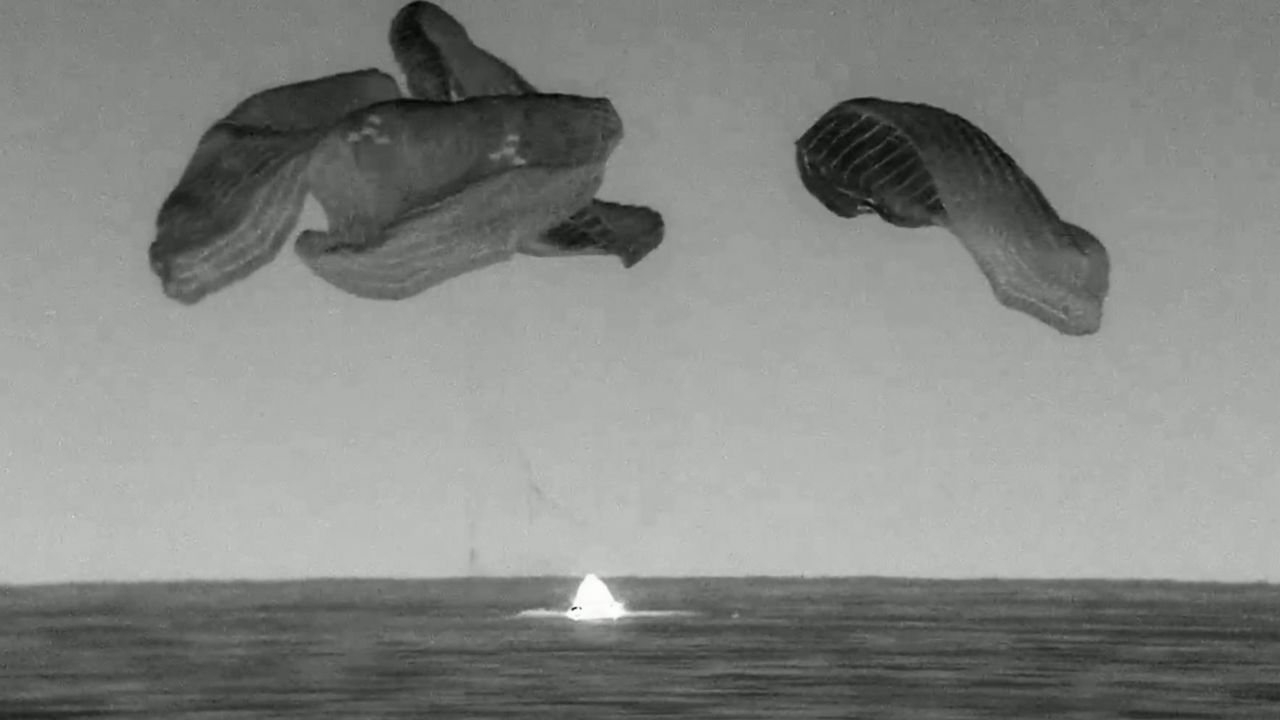KENNEDY SPACE CENTER — After spending nearly six months onboard the International Space Station, the four members of Crew-7 splashed down to Earth early Tuesday morning.
What You Need To Know
- The undocking happened at 11:20 a.m. ET, Monday, March 11
- The splashdown occurred at 5:47 a.m. ET, Tuesday, March 12
- Learn what type of speeds they experienced during the splashdown
- Get more space coverage here ▶
- 🔻Scroll down to watch the splashdown🔻
- 🔻Scroll down to follow the Dragon to splashdown🔻
Countdown to splashdown
#Crew7 is ready for pickup!
— NASA (@NASA) March 12, 2024
Our crew splashed down off the coast of Pensacola, Florida at 5:47am ET (0947 UTC). Next, they'll sit tight inside Dragon Endurance as recovery crews safely rendezvous with the spacecraft. pic.twitter.com/38GnnchdhV
SpaceX Dragon specs:
|
|---|
Crew-7 crewmates NASA astronaut Cmdr. Jasmin Moghbeli, European Space Agency (ESA) astronaut and pilot Andreas Mogensen, and mission specialists Japan Aerospace Exploration Agency (JAXA) astronaut Satosh Furukawa, and Roscosmos cosmonaut Konstantin Borisov took SpaceX’s Dragon space capsule Endurance for their commute home back down to Earth.
The four space frontiers people were in the Dragon as it splashed down in the Gulf of Mexico off the coast of Pensacola, Fla., at around 5:47 a.m. ET, Tuesday, three minutes earlier than what NASA originally stated.
Moments after splashdown, Moghbeli confirmed that all were safe and thanked both NASA and SpaceX for their help during the mission.
SpaceX’s recovery vessel Megan was waiting for their arrival. Once they were collected, they will be flown to Houston, Texas, for their recovery and evaluation, NASA stated.
Nothing like an early-morning swim.
— NASA (@NASA) March 12, 2024
Technicians have secured the Dragon spacecraft to the recovery ship and hopped clear as it's slowly lifted aboard. pic.twitter.com/UfJAFk7raz
Their commute home started on Monday at around 11:20 a.m. ET after undocking from the ISS’s Harmony module. It was supposed to be at 11:05 a.m. ET.
The four were in the Dragon and belted in since before 9:15 a.m. ET.
#Crew7 is set to splash down in the Gulf of Mexico at 5:50am ET (0950 UTC) on Tuesday, March 12—and you could see Dragon as it reenters Earth's atmosphere!
— NASA (@NASA) March 11, 2024
Check out where and when the spacecraft will be visible, then join us for live reentry coverage starting at 4:30am ET. pic.twitter.com/Y7T6C76mEl
Speeding home to Earth
The Dragon was fully autonomous from the moment it undocked to the splashdown, yet the crew could take control of it if needed.
And that commute home was something else. Using a series of parachute deployments, the Dragon slowed down from an orbital speed of about 17,500 mph (2,816 kph) to 350 mph (482 kph) to about 16 mph (25 kph) when it softly landed off the coast of Florida.
Dragon’s four main parachutes have deployed pic.twitter.com/CACzHRxWBv
— SpaceX (@SpaceX) March 12, 2024
And going at those speeds before the splashdown meant that people in the states below the Dragon's flight path, including Florida's Pensacola, may have heard a sonic boom.
Learn all about sonic booms here.
The Crew-7 mission lifted off from NASA’s Kennedy Space Center’s Launch Complex 39A on Aug. 26, 2023, and spent nearly six months onboard the floating laboratory conducting tests and experiments.
NASA stated this is the first mission where each crew member is from different space agencies.
Last week, Crew-8 arrived at the ISS and the crews got to spend a little time together.
Watch the splashdown




